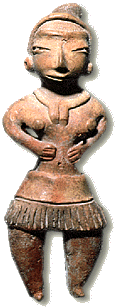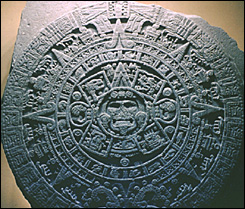
Female Figure with Skirt, 1000-500 B.C. Tlatilco Culture, Valley of Mexico, Mexico. Earthenware: 4" x 2". Purchased with Endowment Funds
Aztec Calendar Stone.. Photo courtesy of Media for the Arts.

THE RELIGIOUS ENVIRONMENT
Complex hierarchies of gods developed in urban cultures that used calendar systems to map the spiritual and material cosmos. Ceremonial centers served as sites of pilgrimage where priests reenacted the gods’ first deeds of creation, sacrifice, and warfare. All of life was seen as a ritual. By imitating the acts of the gods, humans helped maintain the fertility of the earth and universal balance.